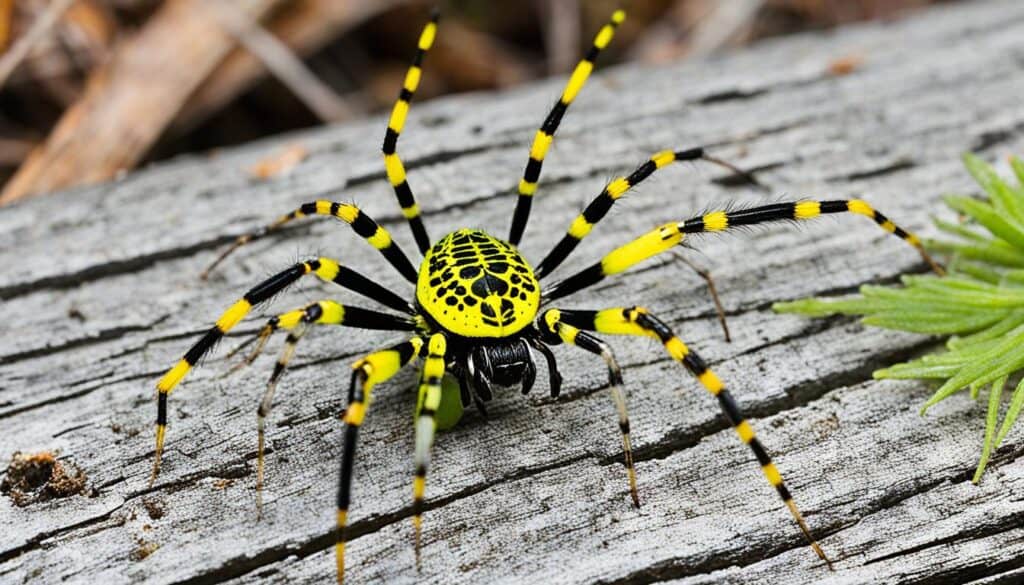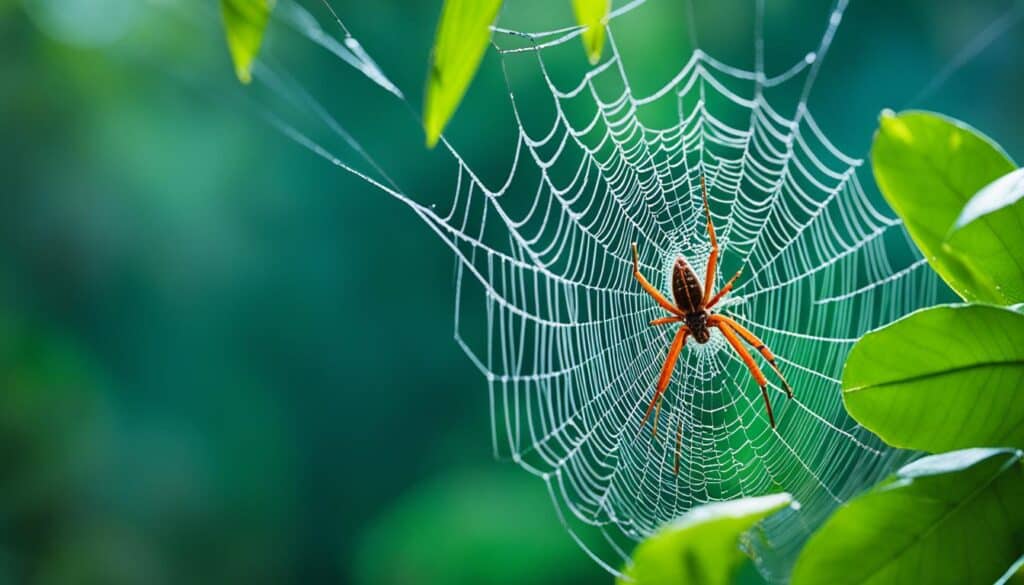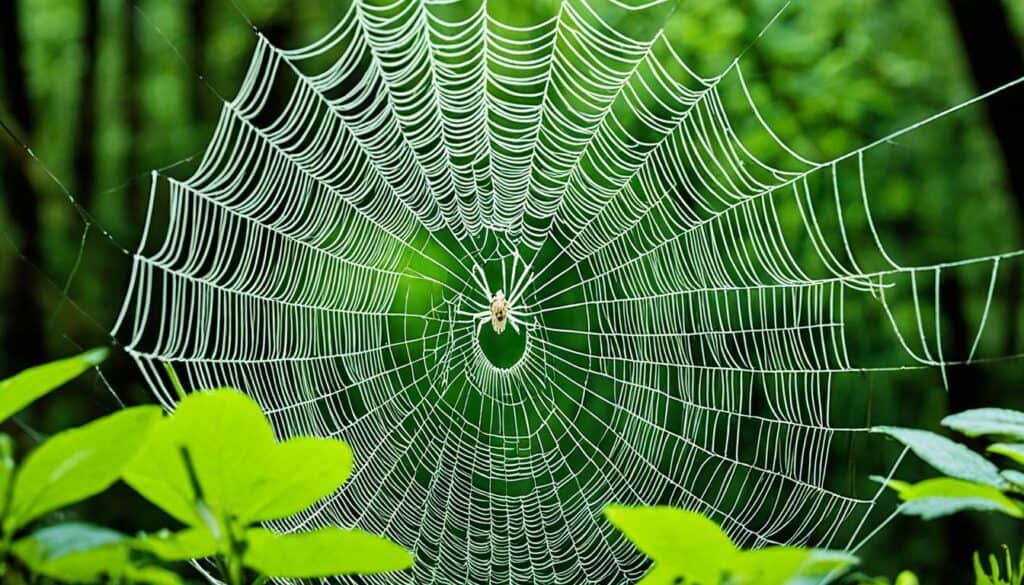Did you know the invasive Joro Spider has made a big mark in the United States? Since they were first found in northern Georgia in 2014, these colorful spiders have spread. They now live in Tennessee, North Carolina, South Carolina, and Georgia. A second group has also popped up around Maryland. What makes people pay attention to these spiders? Joro Spiders, as young ones, use silk strands caught in the wind to fly to new places. This unique way of moving around, along with their one-year lifespan and potential to grow up to four inches, worries people about the East Coast’s environment.
Key Takeaways
- Joro spiders have invaded at least 120,000 square kilometers in the U.S., mainly in Georgia, Tennessee, North Carolina, and South Carolina.
- Their special ‘ballooning’ method lets young spiders move to far places on silk strands blown by the wind.
- Studies show they might be causing fewer native orb-weaver spiders to exist, which is a big concern for the environment.
- Even though they’re not dangerous to humans or pets, their quick increase in numbers makes people wonder about their effect on different living things.
- It’s very important to work on saving our natural areas from these invaders to keep our ecosystems healthy.
Introducing the Joro Spider: A Newcomer to the East Coast
The Joro spider, an invasive species from East Asia, has rapidly spread across the East Coast. It arrived by hitching a ride on cargo ships from China or Korea. Imagine a three-inch spider landing in your backyard, thanks to a skill known as “ballooning.” This phenomenon is made possible by our global trade.
Seeing a Joro spider can be quite surprising. These creatures have quickly expanded their territory in the southeastern U.S. They’re mainly found in Atlanta but are also reaching into the Carolinas and Tennessee. In the last two years, they’ve even shown up in Baltimore. These spiders love to roam.
Joro spiders feast on insects caught in their carefully spun webs. While their venom won’t harm most people, some might get an itchy bite. They’re not dangerous to humans.
The Joro spider’s arrival shows how invasive species can upset local ecosystems. They travel great distances, changing habitats and competing with native spiders. The effect they have on food chains concerns scientists. It’s unclear how far north these spiders might go.
The introduction of the Joro spider is a direct result of global trade. Cargo ships can bring unexpected guests like these spiders into new areas.
Understanding the Behavior and Nesting of Joro Spiders
The Joro spider is truly amazing, capturing the attention of many. With long legs stretching up to four inches, this spider is hard to ignore. Its yellow and grey-blue body shines, making it look like it’s dressed for a fashion show.
Joro spiders are known for “ballooning.” This is where they let out silk that catches the wind, letting them fly to new places. It’s like a big adventure for these young spiders. Though it might sound scary, this method helps them move around 10 miles every year.
When Joro spiders find a spot they like, they start making their homes. Their webs can stretch over three feet, catching prey with their intricate silk designs. It’s fascinating how they turn bugs into food so quickly.
Joro spiders are not just scary; they are beneficial too. They don’t harm humans and eat insects we don’t like. But, they can be tough on local spider species by outcompeting them. This competition can be intense for native spiders.
Joro spiders can also adapt to city life, handling noise and vibrations well. They are spreading from rural to urban areas, becoming well-known city residents.
Conservation and Impact of Joro Spider
Eight or nine years ago, Joro spiders arrived in the United States, posing conservation issues. They probably hitchhiked in shipping containers, ready for an adventure. *Who says world travelers need passports?*
Since their arrival, Joro spiders have caused native species, especially orb-weavers, to decline. People like Barnes have started citizen science projects to help. Now, you can join in and count spiders while gardening. Feeling like an entomologist yet?
People in these projects decide if Joros should be let go or not. Barnes warns that pesticides might kill Joros but harm native spiders too. It’s like using a bazooka against a mosquito. *Not the most delicate solution, right?*
Spotting a Joro is easy because of a red spot on their lower abdomen. They seem ready for a bug ball. Despite their non-threatening venom, their impact on food webs needs more study.
Joros might control pests like stink bugs and mosquitoes. Yet Barnes says we should be cautious in praising them. The total effect of Joro spiders is still unknown. It’s important to study what eats them to understand their impact better.
However, Joro spiders have sparked interest in conservation. Communities are coming together to spot these spiders. In some areas, 50 can gather in a 94-yard space. Their spread to over 120,000 square kilometers is notable. They might become new ecological ambassadors, despite debates.
In places like Georgia and Tennessee, Joros are disrupting ecosystems by displacing native species. Physically removing them, rather than using pesticides, is advised. They’ve adapted well to both natural and urban settings.
Research continues on how Joros spread and affect local wildlife. These spiders are quite large, with a body up to an inch long. Though shy and harmless, their bites are less painful than a mosquito’s. So, we should observe these intriguing creatures carefully, balancing their management and our ecosystem’s health.
My Personal Battle with Joro Spiders
I love my garden in New Jersey dearly, but Joro spiders have turned it into an adventure. These colorful creatures came from Georgia in 2014, reaching the coast. Their arrival added both beauty and worry to my backyard.
Imagine relaxing in your garden and suddenly seeing a huge spider web. Encountering Joro spiders has turned me into a spider watcher, though hesitantly. The thought of these spiders calling my garden home is unsettling.
Joro spiders seem to want more than just my garden; they eye my whole property. Learning the difference between native spiders and invasive Joros has become crucial for me. This is because dealing with Joros is hard. They’re quickly spreading, even reaching South Carolina. Studies suggest they might spread further.
Joros landing at my house via ballooning is fascinating yet scary. It’s tough balancing my fear of spiders with the need to respect native wildlife. I’m always trying to protect my space from these spiders while not harming the ecosystem.
This situation feels like I’m in a spider movie but without any powers. It’s funny how these spiders don’t even know I exist. Fighting these garden intruders has shown how personal invasive species issues can be.
Public Perception and Myths about Joro Spiders
The public sees Joro Spiders through a mix of scary stories and movies. These myths go around faster than their “ballooning” method. First spotted in northern Georgia in 2014, people wonder if they can fly. But really, they can’t. Their “flying” is just them using the wind to move when they’re young. And they won’t dive bomb you like in the movies.
The internet might scare you, but Joro Spiders won’t turn your backyard scary. Their bite doesn’t hurt humans, only their prey. Yet, wrong info leads to needless fear. This fear can make people forget the real facts.
We need to clear up wrong ideas about these spiders. Often, news makes it seem like they are after us. In truth, they just want to lay their eggs and do their thing. Misleading stories can hide the real issue. Like the worry of them harming native spiders or bugs we need.
Think twice before you get scared of Joro Spiders. They’re not looking to attack. They bite only if you bother them a lot, which isn’t a good idea. We should teach the right balance of knowledge. An informed community is less likely to be unfairly scared.
So, if you see a big spider, don’t freak out. Imagine you’re a naturalist, see how they help by eating pests. They’re not the bad guys here. Let’s help change what people think. Share true stories instead of scary myths. Even spiders need a chance to be seen in a positive light.
Conclusion
We’ve learned a lot about Joro spiders. These spiders have made a big splash along the East Coast. They went from 50 spiders in a small area to covering states like Georgia and Tennessee. Check out their story here. They’re becoming part of the local scenery.
Experts, including Coyle and his team, looked at 20 different things to figure out where these spiders might go next. It appears these colorful spiders could spread through much of the eastern U.S. They’re great at catching insects, which might change the local ecosystems a lot. This could shake up the food web in ways we don’t fully understand yet.
These spiders have a unique way of moving around, called “ballooning.” They can also hitch rides with humans. This is why they’re spreading so quickly. While they might push out some local species, learning more about them can improve our plans for handling invasive species. It’s vital we all learn about this and work together. Read more about our efforts here.
So, we’re looking at the big picture, figuring out how to live with Joro spiders. Research and getting people involved are key to this balance. Whether they turn out to be good or bad for our ecosystem, we need to pay attention. Together, we’re stepping into an interesting time for our environment.




